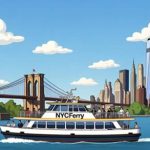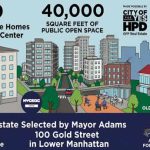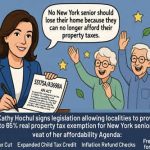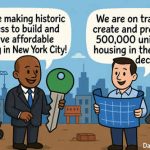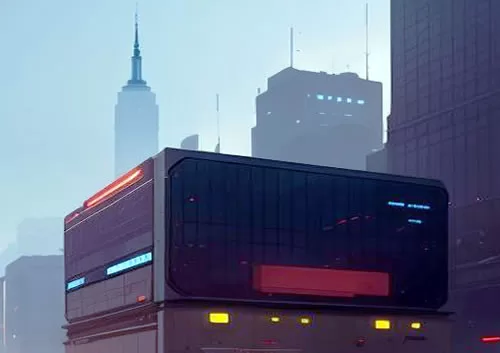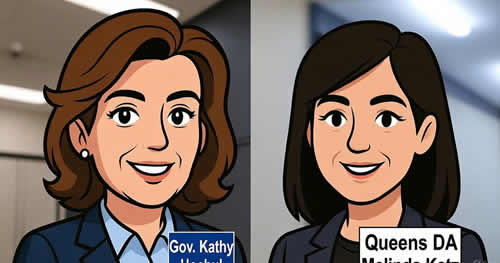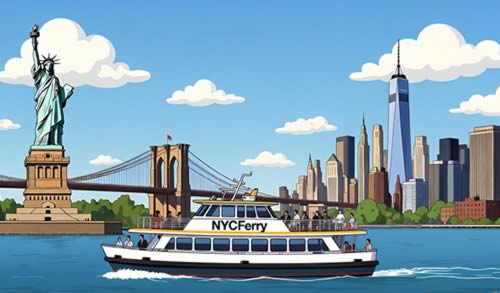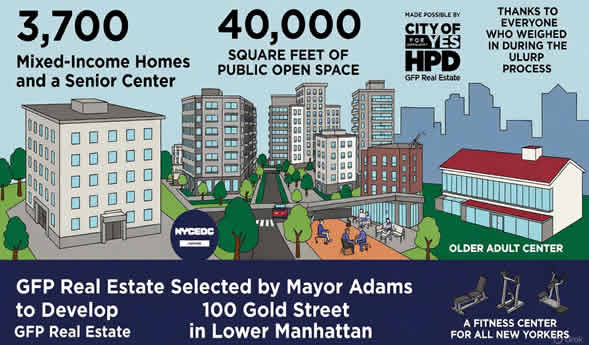Deputy Mayor Meera Joshi and Mayor Eric Adams highlighted the pervasive issue of scaffolding in New York City, emphasizing its importance for public safety but also its negative impact when left up for too long. Mayor Adams stressed the need to remove outdated scaffolding, which not only detracts from the city’s aesthetics but also poses safety risks and hampers local businesses. The city’s initiative, “Get Sheds Down,” aims to incentivize property owners to complete repairs and remove scaffolding promptly, with new legislation and design improvements to ensure a safer, more attractive urban environment.
Deputy Mayor Meera Joshi, Operations: Good morning, everyone. Thank you for joining us. We’re here today on 8th Avenue because, unfortunately, scaffolding is everywhere. It’s on 8th Avenue. It’s throughout our wonderful city. And in some places, it’s doing its job. It’s keeping pedestrians safe from unstable facades. And it can and has been a lifesaver. Yet, sadly, some families like those of Grace Gold, Greta Greene, Erica Tishman, know all too well the tragic consequences of a faulty facade and no scaffolding.
Scaffolding has an important safety role in our city. But when owners leave them up too long instead of doing the work or when the cycle of inspections requires them up over buildings at a frequency that doesn’t make sense with modern building practice, they’re not protecting the public. Scaffolding today is soulless green and steel. They shroud one of our city’s greatest public assets, our sidewalks. And too often, they keep us from the businesses hidden underneath. Only mushrooms prosper in the dark. So now let me bring on our scaffolding, busting, shed busting, rat hating number one get stuff done, boss, Mayor Adams.
Mayor Eric Adams: Thank you. Thank you so much. And as I got out of the car, I spoke with one of my narcotic sergeants who just shared with me an arrest they made yesterday of those who were selling narcotics. And he pointed out there’s a clear correlation between the illegal drug sale and the scaffoldings. These sheds are places where people can hide. They can secrete narcotics and it just adds to the problem.
Not only is it unsightly to see as it lines our sidewalks and our safe spaces, but people with illegal intentions are able to be in the dark and carry out illegal behavior. So this is such an important quality of life issue. We want to just thank all of our partners who are here, particularly the borough president, I mean, the councilman who has talked about this often and has been really a leading voice on this issue that we talked about it and how we could get it done. And we’re here to get it done.
I want to thank the deputy mayor for the entire initiative of Get Sheds Down and how we focus on doing that as part of our overall theme and goal. This is part of the public safety part of revitalizing our economy and making this a livable city for working class people, particularly, but the entire city in general and taking down sidewalk sheds is crucial to this part of our apparatus. It is unsightly for our sidewalks. It’s dangerous and it just makes no sense.
When you do the analysis, you see that sheds may have gone up to keep people safe. But they’re still up because it’s cheaper for building owners to leave them up than to fix their buildings. Just think about that for a moment. The incentive is to keep them up instead of making sure you build the underlying problem of why the sheds went up in the first place. This is bad public policy and it is bad for public safety. And as we are discussing the study today, we want to thank our partners at MasterCard. It’s clearly showing that these sheds are bad for business.
Too many businesses throughout New York City have been shrouded by hundreds of miles of sidewalk sheds, some of which have been up for decades. Decades. We no longer even look at the buildings anymore because you look at the sheds and you think is part of the building. And they have been up so long. Here in Manhattan these sheds can cost businesses nearly $10,000 per month. And that’s just from spending by people using MasterCards. That’s a real, when you think about the razor thin margin of running a restaurant or business, having to pay $10,000 or lose $10,000 a month of business. It’s just a major impact.
And as the survey shows, our restaurants and bars are being hit the hardest. In fact, restaurants and bars are seeing as much as a 10 percent decrease in weekly transactions in the six months following a shed going up. Less business means fewer employees, fewer dishwashers, cooks, bartenders, people who really depend on the economics that come from their employment. It’s a real hit to our hospitality.
The Hospitality Alliance, we’re doing everything possible to continue our success of bringing tourism here. And those who come out and enjoy this beautiful city. But these sheds are having a major impact on the tourism industry and our hospitality, which is the lifeblood of our economy. But our different groups who benefit from these industries are being hit by not having these sheds removed. And that’s why we want to continue to move forward in a very aggressive manner to get sheds down.
We’re not going to let hardworking New Yorkers be taken for a ride by property owners who refuse to fix their buildings and leave sheds up. And we’re going to now make it, incentivize it even more, to get sheds down. Our plan is to flip the script on property owners so repairs get finished. sheds come down, and storefronts remain open. We’re cutting red tape to safely remove these ugly sidewalk sheds and scaffolding across the five boroughs.
Now, we have been successful since we announced Get Sheds Down, D.M. Meera Joshi and her team. We have witnessed 173 linear miles of sidewalk sheds removed from our city. It is crucial when you look at that number. And here in the 34th Street District, thanks to the work we’re doing, we have 50 percent more open sidewalk space than just a year ago. But we want to go further. That’s not enough. We’re not satisfied with it. We want to get all of these sheds down in our city. And we’re working with the council on a bill package that would increase lighting requirements for sheds, reduce the duration of sidewalk shed permits and introduce new penalties and building repairs of building repairs and not perform in a timely manner.
This is how we reimagine our city. We bring back the beautification that’s associated with this great city, not only here in Manhattan, but throughout our entire city. This is a problem that we’re facing and we are focused on getting shut down. Job well done. Thank you, our Council delegation thats here because they played a major role in identifying this problem and using smart legislation to address the problem at the same time. Thank you. Thank you, D.M.
Deputy Mayor Joshi: Thank you. As the mayor noted, the key to getting sheds down is making sure the Buildings Department has the right tools to do it. And that means the cost of putting up a shed can’t be cheaper than doing the work, which is often the case today.
So we look forward, and I’m looking right at our councilmember friends. We look forward to working with City Council to make sure that this penalty legislation passes so we actually have the tools to get the sheds down. But in addition, and in the meantime, we have a program called art bridge thanks to City Council. I’m sorry, art on scaffolding, which allows instead of the green, you can have art make a plug for our wonderful school system and the artists that it generates. They have great ideas.
And also this Buildings Department is doing two important things. One, they’ve got two premier design firms that are currently coming up with different designs, permanent designs for scaffolding that would eventually become a part of the building code. So where we have to have scaffolding, we have better design, scaffolding, scaffolding that shows our public space. And two, they’re working with a premier engineering firm to review Local Law 11. Today, every building is on the same cycle. That may not be necessary. Many other cities have staggered cycles depending on the type of building. But this would be an important change that would allow buildings that have facades that we know are much stronger and newer to have a longer distance between their Local Law 11 inspections.
So I really want to thank the Council, thank Department of Buildings for the work that’s ahead. It’s multi-pronged, but also to thank our partners, especially the retail and the BIDs, because they represent the businesses on the street and the ones that are feeling the direct impact of excessive scaffolding. So first, we’re going to hear from Councilmember Powers, who can also hopefully give a little bit more explanation of the upcoming legislation. Thank you.
New York City Councilmember Keith Powers: Thank you. Thank you. You know, I just want to start by saying that my dad was a small business owner. He owned a restaurant right across from where I live in Stuyvesant Town. And if you put scaffolding in front of his business, people will no longer be able to find it. The public safety elements we talk about would take place. And for any small business, let alone a small neighborhood restaurant, you would be out of business very quickly.
When we talk about all the different reasons why we need to take down the sheds and remove an endless plague of scaffolding in places like Midtown, we’re talking about those small business owners. We’re talking about the people whose livelihoods depend on visibility and on pedestrians finding their business. And far too long, we have surrendered our entire city and certainly in Midtown to allowing the scaffolding takeover of our neighborhoods, take away the visibility to the skyline, but certainly to the signage of many of our beloved businesses as well.
I say this often. We disagree on so much. As New Yorkers, we argue about the best pizza place, Joe’s, in my opinion. The best bagel, Ess-a-bagel. I’m just giving you my recommendations, Yankees, Mets and other things. But when you talk about scaffolding, every New Yorker is in the same exact place and they come together because everybody is sick and tired of it. They’re sick and tired of losing their favorite neighborhood businesses. They’re sick and tired of having their block taken over by it, losing the visibility and losing the safety elements that they want to rely on. They lose a sense of neighborhood and community. And people start to cross the street. Frankly, they don’t want to walk on that side of the street anymore. And I say this often. The only day you like scaffolding is when it’s pouring out in New York City. And so it gives you a little bit of refuge.
But we have been on a mission for the last few years. And I want to thank the mayor for his steadfast commitment to taking down the scaffolding and ending our city’s problem around scaffolding and Midtown is emblematic about it. If you look around, you can, I can see scaffolding right down the block. Anywhere you look in New York City right now in Manhattan, you will see scaffolding. We can do better than that. We have to do better than that.
So we’ve introduced a package of legislation. Councilmember Bottcher is here as well, who has a few bills as part of that package. And we issued a series of recommendations about how we can do better. And we have found a great partner in the mayor and the deputy mayor and our amazing building commissioner, wherever he is behind me, who really want to take that challenge on with us and are really willing to partner with us to get that done. I’m really excited to say we had a hearing on that legislation just a few months ago. We are getting ready to roll our sleeves up and try to get that passed. Hopefully this year. So we can put ourselves on progress and on a path to ending it.
And I don’t go alongside with the Department of Building’s efforts to also reform this process as well. I just want to say deeply thank you to the partners here. We have Senator Hoylman-Sigal at the state level and Councilmember Bottcher, who have been amazing partners in making sure we clean up Midtown and make more sense of its regulations and its rules and give the people their community back. And that’s what we’re about. So thank you to the mayor. Thank you for your team for continuing a steady beat. To take down the scaffolding.
We will get those sheds down. And I will say I just want to say we are. I got stopped by a friend the other day and he said, I’m already seeing it. I’m already seeing it. And we are tweeting out the success stories here. So we are making progress. We have a lot more to do. So thanks to the mayor. Thanks to my fellow elected officials. Let’s get the sheds down.
Deputy Mayor Joshi: And next, we’ll hear from Dan Biederman, head of the 34th Street Partnership, who can speak, I think, very, very accurately about what the feeling is on the street in Midtown.
Dan Biederman, Director, 34th Street Partnership: We, aside from the important things the mayor has to do that are obvious, like bring the crime rate down, and we’re already seeing results on that in our district. Thanks partly to the great work of the PD. There are a bunch of quality of life issues that this mayor, in our opinion, is paying attention to that kind of sat around for too long. Cannabis, cannabis shops is a recent one, and they’re working on that. But the bags at the curb, rat control and sidewalk sheds.
So these are all extremely helpful in creating a better business environment in our district, which starts right at that orange flag. That’s our boundary and goes south. This Manhattan Beauty behind us, a gentleman told Greg Ackell and Dan Pisark, who worked for us on this, business is a lot better since all of you, I don’t know who, combined with the landlord to bring down that shed. So that’s an example right there of improved business as a result. So we are grateful to everybody who’s working on it for this legislation. Thank you, Council. Thank you, state senator. And I want to see more of that. I very much appreciate it. Thank you.
Deputy Mayor Joshi: Now we’ll hear from the man who, together with his amazing team, is actually taking them down, especially the longstanding ones, the ones that have been up for five or more years. Commissioner of our Department of Buildings, Jimmy Oddo.
Commissioner Jimmy Oddo, Department of Buildings: Thank you. Thank you. Good morning, everybody. Thank you, D.M. Thank you, mayor. Thanks to all our colleagues. All of us have heard Mayor Adams talk about crime and frame it in such a way that folks, New Yorkers, not only need to be safe, they have to feel safe. So being safe is the empirical data, right, that shows crime is coming down. The feel safe is the perception New Yorkers have. And every time I hear the mayor frame the fight on crime that way, I think about this battle with sheds, because we at the Department of Buildings have kind of two jobs.
The name of the program is called Get Sheds Down, so you have to reduce the overall number of sheds. That’s a given. But you also have to make sure that New Yorkers feel the difference. So as Deputy Mayor Joshi said, we are attacking it in two different ways in terms of bringing the overall number of sheds down. We at the Department of Buildings like to say every shed is not the same. A shed that goes up for new construction is a good thing. A shed that goes up for maintenance is a good thing. A shed that goes up in response to Local Law 11 could be a good thing. A shed that goes up and no other work happens, no underlying fix is happening and just stays there on and on and on is what Mayor Adams wants us to address. And that’s what we are doing.
We have taken owners to court on longstanding sheds. We have seen more longstanding sheds come down since the mayor has announced Get Sheds Down over the previous calendar year by a pretty good number. We have Thornton Tomasetti, this premier engineering firm that is looking at our facade inspection rules. The mayor and I are New York Mets fans. We know that we’ve had one championship since 1986. We know how infrequent a Mets championship is. Well, since 1990, we have zero, zero comprehensive looks at the facade inspection program, meaning this administration, the Adams administration, is the first administration to say, hey, are these rules applicable today? Should these rules be one size fits all? And Thornton Tomassetti is undertaking this comprehensive review.
We’re looking at other jurisdictions. We’re looking at one international city that I think the mayor will smile about this to see how they’re taking a unique approach of it. We are looking at this mountain of data that DOB now, our digital platform, is giving us. We’re looking at climate change and what that means to our buildings. We’re saying maybe a brand new sort of steel and glass building shouldn’t be treated the same as that brick building. We’re going to bring the number of sheds down. But at the same time, we want to talk about the feel. We want New Yorkers to feel differently. And when you are in a cramped, dark, not very well lit, no light reaching the store and attraction for nefarious activity, bars all around, that’s a vibe that this mayor does not want.
So we have two fantastic firms that are going to give us six new designs early next year that we get to pick from four on the street level and two above street level. And this is different than previous iterations because this will be affordable and this will be built into the building code, meaning you won’t have an option but to build at this standard or above. So you’re going to see the number of sheds come down. You’re going to feel the fact that the number of sheds come down. And I personally think when New Yorkers aren’t feeling it, then this obsession with the overall number might actually diminish. But you’re going to walk down New York City streets and it’s going to be light and it’s going to be open.
And let me close with this. Mr. Mayor, give me 30 more seconds, because it’s rare from a kid from Staten Island that has an audience here in midtown Manhattan. So this may be the closest I come to Bill Maher. Bill Maher has the new rule. I have a new word, the new word of the day. And I tweeted this out a couple of weeks ago and it did not get the traction I expected. SHED-enfreude,, SHED-enfreude, that feeling you and other New Yorkers get when a shed has come down and an area that was dank is now resplendent in light. Word of the day, SHED-enfreude.
Question: Mayor, respectfully, if we go back two administrations, Mayor Bloomberg had a whole team that said, let’s redesign the sheds, let’s get the sheds down. We’re talking 15 years ago. They’re all still up. So why should New Yorkers who hear you say this believe it’s going to be any different?
Mayor Adams: And I think that’s a legitimate question. If you go back in time, many administrations tried to get the Willets Point Project done. We did. They tried to get the housing trust done. They couldn’t. We did. They tried to do so many things from Governor’s Island development. They tried and tried. We did. They tried to develop Brooklyn Marine Terminal. We did. They tried to bring in so many different initiatives. And you see that we have the ability of getting stuff over the finish line.
That is what is our trademark. We take where others have failed and we learn how to achieve them because I’m consistent, I’m persistent and I know how to get stuff done. And so trust me, New Yorkers, where others have failed, we’re going to succeed like we succeeded in those other projects that they failed. We’re moving towards getting these sheds down. We’re dedicated to it. We did a proper analysis. Some people have been playing games and they think they can keep them up as long as possible. We have to look at every pathway that allows these sheds to remain up in our city and we have to dismantle each one of them. And that’s what we’re doing. So we’re going to get it done. Get stuff done. It’s not just three letters. It is something that we do.
[Crosstalk.]
All right, hold on, hold on, hold on. Yeah, but why are you interrupting our press conference? You can see me after you have a conversation, but let’s show a little respect while we’re trying to do this here. Okay, I’ll hang around and talk to you and talk about the seven thousand we’ve removed off the system. But right now, let me finish, okay? Thanks a lot.
Deputy Mayor Joshi: I just want to add a little something to the difference between prior administrations. Under the Bloomberg administration, we saw the Urban Umbrella come out. That wasn’t mandatory. You could opt and it’s still an option today. It’s the only option other than green and gray. You can do the Urban Umbrella. It’s very costly, but it’s not mandatory.
What Commissioner Oddo is doing is coming up with four designs at different price points that will allow the street to be more open and will be part of the building code. And so they will be mandatory. And that’s a huge difference. And the other huge difference is really taking a look at Local Law 11 and that whole cycle, because the cycle of continuous sheds going up is part of the reason that we have so many people that just sort of shrug their shoulders and say, I’ll just leave it up and pay the money.
What doesn’t make a difference until we break that cycle? We’re not going to be able to make a dent. So that’s another distinction. And then finally, the tools, the enforcement tools. So there’s there’s three major distinctions. And we’re really happy with the partnership we have in City Council to make sure that we make this change together.
Question: So following up on that, what is the difference now between the fines, the current fines and you’re saying you’re going to post different fines and also is there a distinction between business scaffold and apartment building scaffolds? I know of apartment buildings that are in lawsuits with each other because the scaffold imposes on the front of their building and they’re up for, you know, 10 years and they’re suing each other. So are there differences and distinctions for that?
Commissioner Oddo: So let’s take it the last point and work backwards. You touch on a really important point, and it’s access agreements between two adjacent property owners. And that we have found is a much bigger factor in the delays in taking down sidewalk sheds than even the argument that some owners are financially unable to do it. And we’ve heard that from owners, we’ve heard that from the industry.
In this past state session, state senator, our former colleague in the Council, Leroy Comrie, got a bill passed in the Senate. Assemblymember Rajkumar has a bill in the assembly. It did not get passed, but we have this coordinated effort to address it. It creates a much more streamlined sort of mediation process because those arguments are costing us time.
In terms of the legislation, I want Councilmember Powers to talk specifically about his bill, but I would just give you so overarching two points. One, this is the public space you are going to have to essentially pay for the public space. If you’re going to leave your sheds up at some point, right, you’re going to have to come back to DOB every 90 days and you’re going to have to pay for that public space. Secondly, we have legislation about the commercial districts in particular. And again, this speaks to the notion of if you have a shut up and you’re not doing any work and we see that, then you’re going to get fined aggressively.
Councilmember Powers: Yeah, I mean, he kind of captured it. We want to make sure that if you’re not doing work, if you’re having it up too long, we are actually having disincentives for the first time, really, to take it down. The second. I’ll get you the details of that on our bill.
The second thing is I want to add that he did mention the state legislation we do in the city folks all together need to push for that state legislation to get passed because in this conversation that we’ve been having, that comes up all the time. Building owners feuding with each other over access agreements, getting into litigation and adding super high costs and delays to this as well. So while we don’t have the city bill, we know about the state bill. I am encouraging everyone to try to help get that bill passed, too.
I’m not sure we can do a city bill on it. We have I think we were looking into it, but we were preempted, I think. But it is something we are supportive at the state level. I think they said the Senate did pass a version of it. So thank you to our Senate colleagues. But we need to get that passed. That’s a big part of the problem as well.
Question: The commissioner mentioned 250 something scaffolds that had been up for five years. Can you give an example of what the conversations have been like with those long standing property owners that have been stubborn about this. But what those conversations have been like, what the enforcement has been like.
Commissioner Oddo: Sometimes those conversations happen in court. Now, we have Rachel McDonough on our DOB team who’s a one woman dynamo that’s bringing a series of cases in criminal court. Now, it doesn’t mandate when we win. It doesn’t mandate that the shed comes down and imposes another penalty. But it gets their attention. And also we’re working with our colleagues in the law department to bring affirmative litigation. We actually have outside the criminal court. We have one in the Supreme Court recently.
We’ve done everything. We’ve done the human touch. We’ve done the one to one phone call. We’ve had our new deputy commissioner for enforcement get on the phone to talk to the licensed professional. We’ve tried everything. That’s why the new legislation is so important, because it gives us new tools to say hello. It’s us. And also to get to the heart of the matter, those redesigns and then the Local Law 11 changes. So any tool in our toolbox, court legislation, human touch we’ve used. Some owners continue to thumb their nose to us and we keep a list.
August 14, 2024 New York NY
Sources: Midtown Tribune news, NYC.gov
Big New York news BigNY.com

